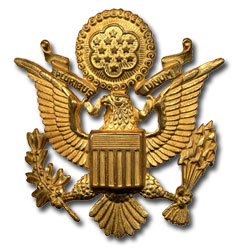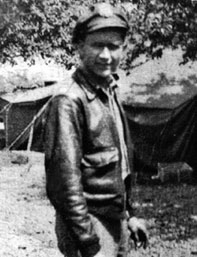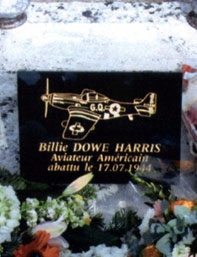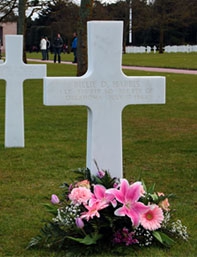The 62-year search by Peggy Seale Harris for her husband, Lt. Billie Dowe Harris, who was listed as missing in action in France during World War II.
When Billie Dowe Harris and Peggy Seale married on Sept. 22, 1943, they were like most young couples of that time – young, in love and full of hope. Despite the fact that the United States was fully involved in World War II, and lives were being changed daily, the 2nd Lt. and his bride were full of confidence in the future as they said their vows. Little did they realize how very different that future would be.
“We actually met through the mail,” Peggy Harris recalled. She was working as an electronic instrument mechanic at Altus Air Force Base at the time. A daughter of Mr. and Mrs. W.P. Seale of Vernon, Harris commuted each day to her job in Altus where she spent her time climbing in and out of airplanes, checking and replacing instruments.
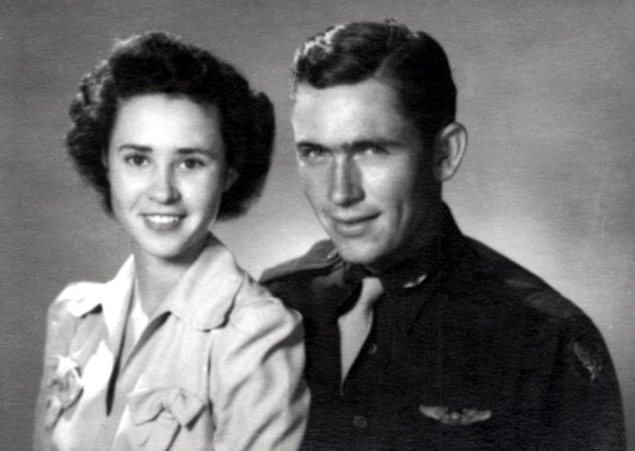
Newlyweds Peggy and Billie Harris.
“Billie’s father and I both worked at the base, and he kept telling me about his son, who was stationed in San Antonio. He wanted us to meet,” Harris said. A son of Virgil and Nell Harris, Billie D. Harris was an Army Air Corp flying cadet at Brooks Air Field in San Antonio where he was undergoing flight training. He and Peggy Seale corresponded for several months, and shortly after meeting, the handsome lieutenant proposed to the pretty Texas girl. He was 21 and she was 18. The couple was married in Florida where Lt. Harris had been sent to undergo advanced training prior to being shipped overseas.
“I didn’t even have money to buy him a wedding ring,” Harris said. “I used my Vernon High School class ring instead, and he wore it as his wedding ring.” Although the couple was expecting to have two weeks leave for their honeymoon, their time was cut short when a troop ship of pilots was torpedoed in the Atlantic.
Lt. Harris’ group was tapped to take their place. “His group was all taken to Tallahassee, and the wives were taken there to a huge hotel. When the men were called up, the wives were told to go home and not tell anyone that their husbands had been sent overseas until they had arrived there safely.” It was October 1943, and unbeknownst to Harris, it would be the last time she would see her husband.
Lt. Harris was assigned to the 355th Fighter Squadron/354th Fighter Group, stationed in southeast England. During the next few months, he would fly bomber support missions into Germany in the P-51 Mustang. After the invasion of Normandy, France, the attacks changed to ground targets with Lt. Harris flying multiple daily missions across the English Channel. During this time, he would earn two Air Medals with 11 oak leaf clusters and the Distinguished Flying Cross. “He told me very little about what he was doing,” Harris said. “There was a lot of censoring of the mail, but I knew he was flying missions.”
By July 1944, Lt. Harris had completed over 60 to 100 missions and was eligible to be sent home. “He wrote to me that he would soon be home. In fact, he had been assigned a place on a returning troop ship only to learn that wounded had priority, and he would have to wait for another ship. I thought it was only a matter of time until he would be able to come home.” The date was July 8, 1944.
In late July, Harris received a telegram stating that her husband was “missing in action” as of July 7, 1944. The telegram would be the first mistake in a long series of errors that would interweave itself into Harris’ life for the next 62 years. “After I got over the shock, I went to the telegraph office and told them there had been a mistake,” Harris said. “I told them I had a handwritten letter dated July 8, so he couldn’t have been missing on July 7. I didn’t know if the telegraph operator had made a mistake or if it was a mistake at the war department.” Harris subsequently received a second telegram correcting the missing in action date to July 17, 1944.
She was in Colorado at the time, having been convinced by friends that she needed to get away from her job and take a rest. “I was working at the air base while Billie was overseas, and one day, I was taking an instrument panel out of an airplane in which someone had been killed. There was dried blood still on the panel. I just couldn’t do it anymore after that, so I went up to Colorado for a while.”
Later, an official military release was sent to Harris from Supreme Headquarters in Allied France (SHEAF) asserting that Lt. Harris had returned to the United States on leave. But none of the family had heard from him. Not convinced that her husband was in the United States and with no further information on his whereabouts, Harris appealed to the Red Cross for assistance. “I was told not to be concerned, that no doubt he was being ‘processed,’ possibly at some military hospital,” Harris recalled. Lt. Harris’ wife and family were hopeful that would be the case. “Billie’s parents and I choose to believe that he was back in the United States. We were hoping that he was in a hospital somewhere, and maybe just didn’t know who he was or had lost his memory. We had heard of cases like that.”
By March 1945, when no further word came concerning Lt. Harris, his wife again went to the Red Cross and asked if the military hospitals could be contacted. “I was told it was too expensive to launch a search, and they were sure Lt. Harris would soon appear.” Harris next contacted Congressman Ed Gossett in Washington D.C., who in turn sent the information to the International Red Cross in Switzerland. Thereafter began a long series of conflicting reports, including notification that Lt. Harris was missing in action, then killed in action, then again missing in action. It appeared no one could agree on what had happened to the young pilot. In fact, no one seemed to know what had happened.
In 1948, Harris received a government form requesting her to indicate where Lt. Harris’ remains should be interred. “I really didn’t believe they were talking about Billie because we still didn’t know where he was,” she said. In fact, Lt. Harris’ father had been told by a friend in California that he was certain he had spotted the young airmen on an elevator in California.
“Mr. Harris quit his job and went there in hopes that he would find his son. Our thought was maybe he was out there somewhere and had lost his memory.” However, on advice of a lawyer, Harris signed the papers from the military, and this eventually allowed her to receive military benefits, something she had not been able to do until that time. She did not, however, believe that her husband was dead.
“Until his parents died in the 1980’s, they also continued to have hope that their son was alive,” Harris said. And the story might have ended there with Harris never knowing what had happened were it not for a cousin of Lt. Harris who had become intrigued with the situation.
“Billie’s cousin, Alton Harvey, had heard the story of Billie all of his life. He was born after Billie died. He wanted to know what really happened, and after he retired, he began searching for the truth.” During his extensive research over the past few years, Harvey found that some pilots had been buried in France, and he discovered that files were now being made available from the Department of the Army. Initially, however, he was told it would be difficult to access the files because of limited staff. A few days after his inquiry, however, he received a call from Washington D.C., informing him that a Frenchwoman had also been inquiring about the same files some six months earlier. The files had been pulled and were available.
The Frenchwoman, it turns out, was Valerie Quesnel of Les Ventes, France. Quesnel was a board member of the little French town, which in 2004 decided to observe the 60th anniversary of the French liberation. It was during these preparations that the complete story regarding Lt. Harris would come to light. Representatives from the French Embassy in Canada were invited to attend the ceremony, which paid tribute at a war memorial to citizens who had been killed in an air raid on the town in 1944, to those who had fought in the French resistance, and to a pilot whose plane had been shot down in the nearby woods - a Canadian named Lt. Billie D’Harris. However, an article detailing the 2004 ceremony caught the attention of a Mr. Huard, president of the Normandy Association for the Remembrance of Aerial. Huard wrote to the town council that he believed the pilot in question was not Canadian, but an American. It was also noted that the pilot’s body had been moved from the town in 1946, although a large marker remained there, and had been temporarily buried in another cemetery, then later permanently transferred to the Normandy American Cemetery at Colleville-Sur-Mer.
Quesnel made a trip to the cemetery and confirmed the information. It was then that she began her research through the Department of the Army in Alexandria, Va. In September 2005, Quesnel received over 200 pages of information concerning Harris. It was about this time that Harvey’s research had led him to the same department, and he also was able to obtain the information.
Harvey and his wife drove from Austin, where they currently reside, to Harris’ home in Vernon to personally present her with the documentation and perhaps the last piece of a puzzle that had gone unsolved for over 60 years. Among the information was the name and address of Quesnel. Harris immediately wrote a letter expressing her appreciation to the small town of Les Ventes for their original burying of her husband there and the subsequent years of tribute they had paid to his honor. Thereafter a correspondence began between the two women, and Harris was able to finally learn what had happened on that July day in 1944.

